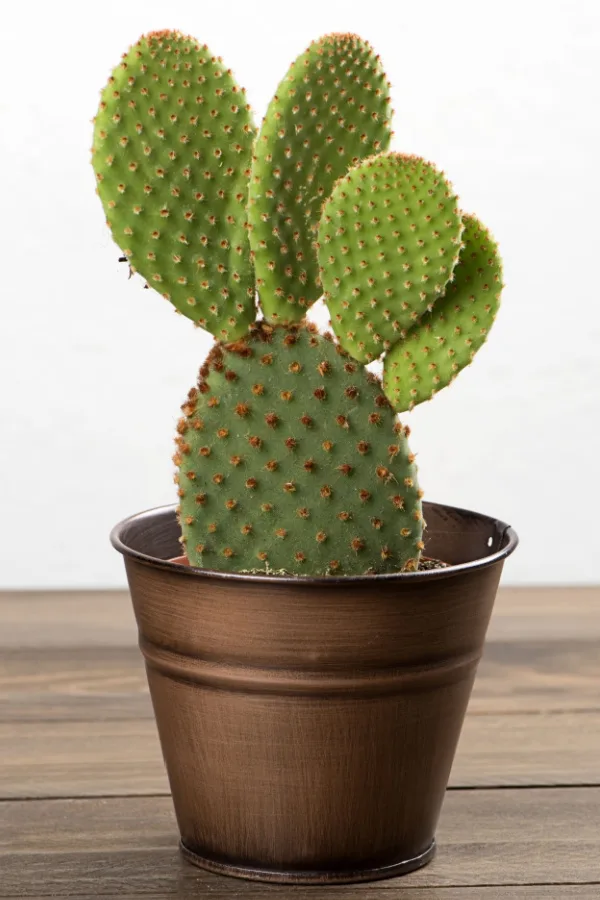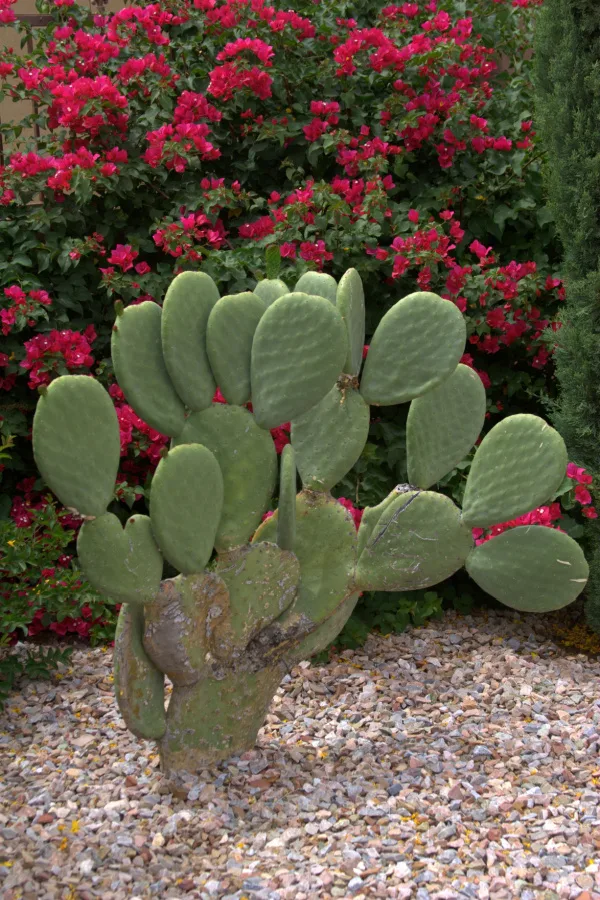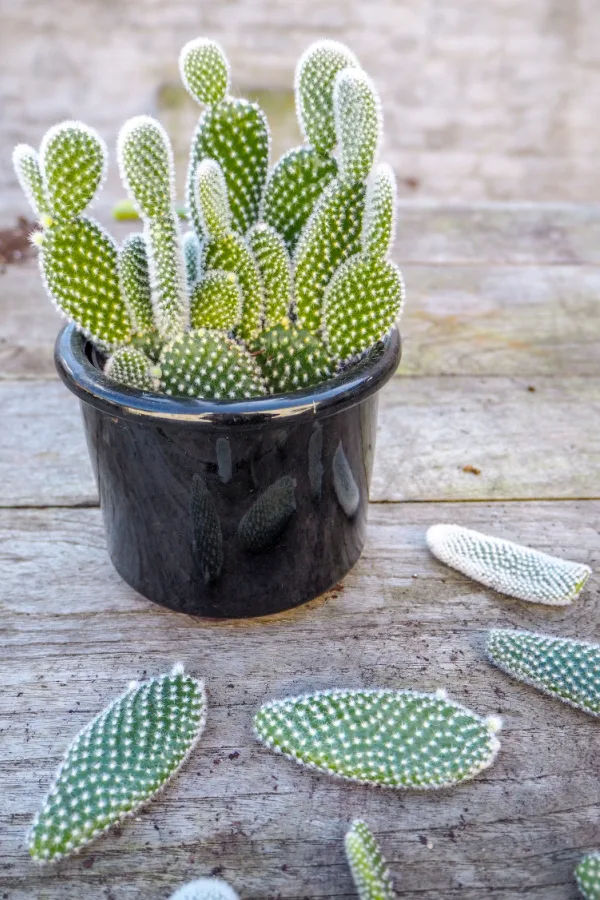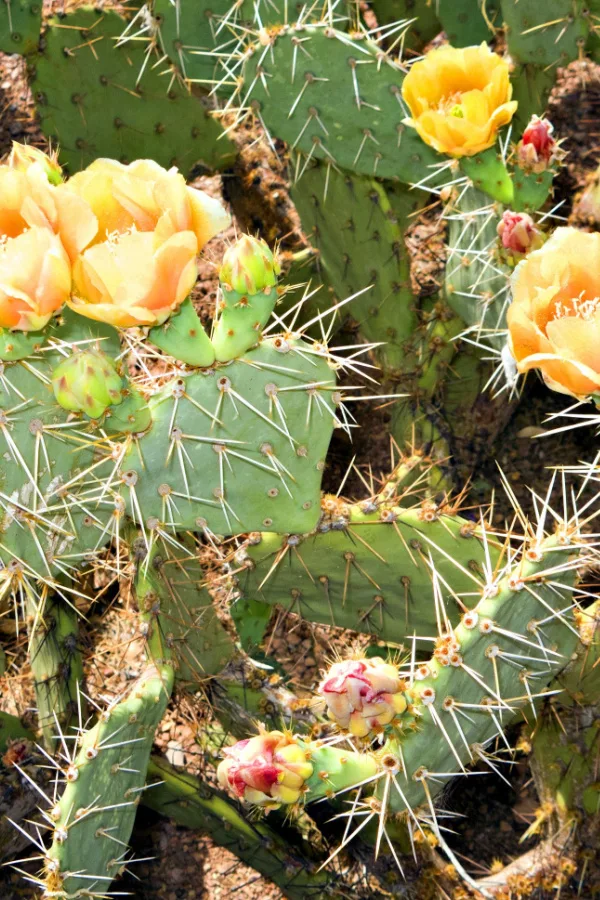Looking to add a little bit of the desert feel to your landscape or home? Then consider growing prickly pear cactus!
The prickly pear cactus is a flowering evergreen perennial from the genus, Optunia. It is one of the most widespread cacti groups in the entire World, with well over 150 different types of cultivators.
The prickly pear cactus features large, flat pads that are in the shape of thumbless mittens. They grow from one central pad and continue to rise in height. They have a waxy texture that helps to protect the plant from harsh desert elements.

The thick pads are covered in spines that can grow to be up to 3 inches long depending on the variety. Some of the prickly pear cactus varieties even have spines that detach upon contact and end up being an uncomfortable parting gift for those who pass by!
They look stunning next to other unique and low-maintenance houseplants like holiday cacti, jade plants, and succulents. But whether you keep them indoors as houseplants or plant them directly in the ground, the prickly pear cactus is a great addition to any home or property!
How To Plant, Grow, And Maintain Prickly Pear Cactus
Depending on your climate and location, you can grow prickly pear cacti outdoors in the soil or in pots and containers. Different varieties are hardy in growing zones 4 through 11, but you can grow them indoors year-round. Just choose a spot indoors that gets bright, indirect sunlight like an east or south-facing window. You can also use grow lights if needed.
For milder locations, you can grow cacti in pots and containers outdoors. You can just bring them inside during the cooler weather months when the plants go dormant. Once spring rolls around, you can bring them back outdoors for blooming and pollination.
Plants can vary from as small as one foot tall once they mature all the way up to a towering 15 feet tall depending on the species. They are also known to spread when planted outside when their fruit falls to the ground and the seeds self-germinate.
Planting Prickly Pear Cactus
You can really grow prickly pear cacti by a variety of different methods. Some are definitely a bit more hands-on than others, but there’s an option for everyone.

When handling any part of the prickly pear cactus or cuttings, be sure to always wear thick gloves and appropriate clothing. You don’t want to end up with one of those spines as a painful bonus! Also, don’t be alarmed if some of the spines do end up breaking off when handling; They will grow back with time.
Growing From Seeds
Growing prickly pear cactus from seeds is definitely the slowest method of planting available for cacti. However, it can also be the most rewarding. Seeing something you started from a tiny single seed turn into a huge plant is worth the extra time and effort for many.
Start by choosing a potting soil mix that drains well and is geared toward cacti and succulents. Pick a small container that has plenty of drainage holes and fill it with your pre-moistened potting soil mixture. Add one to two seeds per container depending on the pot’s size. Cover with about an eighth of an inch of soil and keep in a warm location.
Cover lightly with plastic wrap or a plastic lid to help retain moisture. Ensure that the soil stays moist, misting lightly if needed. Be patient since the seeds may take anywhere from a few days up to almost half a year before germination occurs.
Sowing seeds outdoors is similar. Wait until the threat of frost has passed before sowing seeds outside. Choose a location that has loose, well-draining soil and receives plenty of sunlight. Also make sure it is in a location that is protected from harsh winds.
The spacing of your seeds is going to depend on the variety of prickly pear cacti you are growing and their mature size. You can always sow more seeds and then thin them once they have germinated and are a few inches tall. Most should be spaced around two to three feet apart though. Keep the soil moist after planting but avoid standing water. Again, be patient and allow time for seeds to germinate.

Planting Transplants
Planting transplants either directly in the soil or in a container is probably the easiest way to get your prickly pear cactus growing strong – provided you wear the appropriate gloves and clothing!
For most varieties, choose an outdoor location that has well-draining soil and that receives full sun. Some varieties can tolerate more shade than others, so be sure to do some research before planting in the ground.
For container planting, choose a vessel that is wider as opposed to taller. This will help to balance the prickly pear cactus as it grows since the roots do not grow deep but rather spread out. Also, the plants can get rather top-heavy, so consider a heavier container like a terracotta pot.
No matter what, the container needs to have plenty of drainage holes. Use a potting soil mix that is geared toward cacti and succulents for pots and container growing.
Whether you are planting in a container or in-ground, create a hole in the soil that is slightly wider and at the same depth as the current root ball. Carefully, remove the transplant and set it in the hole, being sure to not bury part of the main pad. This can cause rotting and other issues.
Backfill and water to help set the soil. You will want to water about weekly until the roots start to grow and the plant becomes more established.
Planting Cuttings
Last but not least is growing from cuttings. This is also an easy way to propagate new plants for free all by using cuttings from a mature prickly pear cactus plant.

Carefully remove an entire pad from a mature plant. Allow the cutting to dry for a couple of days. Then place the pad upright with the cut side in a container with cacti potting soil mix. Water to help set the plant and then not again until it starts to set roots.
You can tell when roots have grown by lightly tugging on the cutting (while wearing gloves!). If it comes right out, it needs more time. If the pad gives you some resistance, then the roots have likely started setting.
Long-Term Care – How To Grow and Maintain Prickly Pear Cactus
The good thing about growing prickly pear cacti is that there is hardly any maintenance once your plants are growing and established.
Watering
Since they are native to warm, arid locations, overwatering your prickly pear cactus is more of an issue than underwatering. For in-ground plants, if you do not receive any rain for a couple of weeks in a row, then water your cactus with about an inch of water. Otherwise, let mother nature take care of the watering for you.
For container plants, water about once every two to three weeks or whenever the soil is completely dry. Water about once a month during the winter months. This will depend a bit on whether the containers are indoors or outdoors and their overall size.
Fertilizing
You can add fertilizer if you want during the active growing season (spring and summer) to help the blooms and fruit set. Use a product that is geared toward cacti plants and follow the package directions.

Pruning
You only need to prune your cactus if it starts to spread or grow too large for its location or container. Just be sure to trim off entire pads when pruning and never remove more than a third of the plant at one time.
Winter Care
During the winter, prickly pear cacti will go dormant. Don’t be surprised if the pads start to shrivel some in the process; It’s all completely natural.
If the prickly pear cactus is planted outdoors in warmer climates, you can cover it during super cold nights with burlap or other thicker materials. For container plants where temperatures will continue to stay below freezing, you can bring them indoors once temperatures start to drop.
Keep in mind that some varieties are more cold-hardy than others, so choose your cactus wisely when purchasing. With a little basic care though, you can enjoy growing prickly pear cacti no matter where you live!
Follow Our Facebook Page For Even More Great Tips! Simple Garden Life Facebook Page
Simple Garden Life is a website dedicated to keeping gardening fun, simple and enjoyable! We publish two new articles each week along with a new garden podcast episode every two weeks. This article may contain affiliate links.
